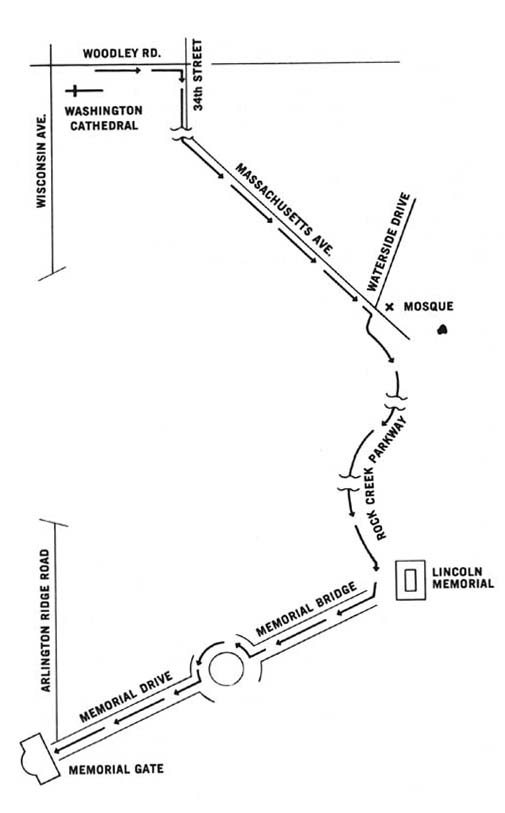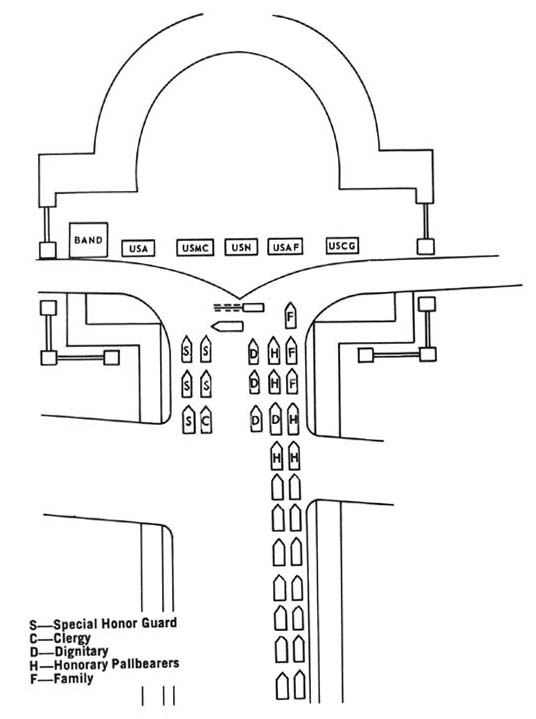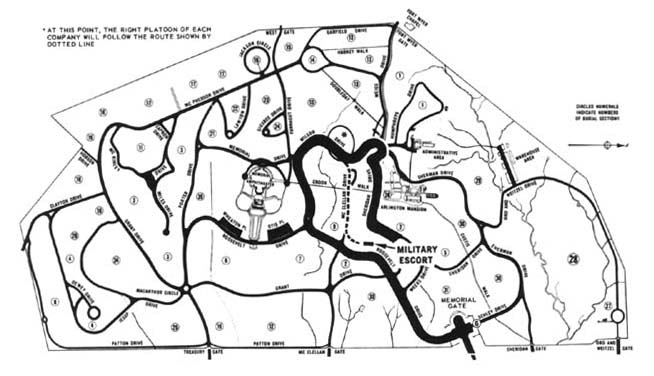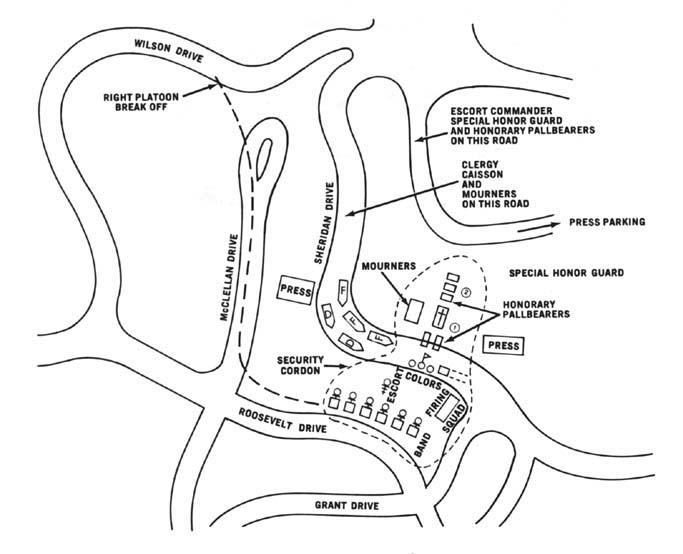|
The
Last Salute: Civil and Military Funeral, 1921-1969
CHAPTER XVIII
Fleet Admiral William F. Halsey, Jr.
Special Military Funeral
16-20 August 1959
On 16 August 1959, less than a month after the death of Fleet Admiral
William D. Leahy, another five-star admiral, William F. Halsey, Jr.,
at the age of seventy-six died of a heart attack at Fishers Island,
New York. For the second time within a month, the Potomac River Naval
Command became responsible for arranging the ceremonies of a Special
Military Funeral, which was held for Admiral Halsey on 20 August. The
admiral's body was meanwhile taken from Fishers Island to the chapel
of the Navy Receiving Station in Brooklyn.
According to plans, which incorporated the wishes of the Halsey family,
the admiral's body was to be brought to Washington, D.C., for the funeral
service and burial. The body was to lie in Bethlehem Chapel at the Washington
National Cathedral from noon of 19 August until the same hour on the
20th. The funeral service was to be held in the nave of the cathedral
at 1400 on 20 August, and burial was to follow in Arlington National
Cemetery. The gravesite selected was in Section 2, near the grave of
Admiral Leahy, and next to that of Admiral Halsey's father, who had
been a Navy captain, and mother.
Announcements of the funeral service for Admiral Halsey, which served
as invitations to attend, were issued by the Secretary of the Navy,
but they were sent out and the responses were recorded by the Office
of the Chief of Naval Personnel. Dignitaries and their wives who were
invited to attend included the President, Vice President, members of
the cabinet, justices of the Supreme Court, members of Congress, members
of the diplomatic corps, officials of the Department of Defense, and
representatives of patriotic organizations. Flag and general officers
of all the uniformed services, active and retired, residing in the Washington
area also were invited.
Among the friends and associates of Admiral Halsey who were asked to
participate in the funeral and burial services as honorary pallbearers
was Deputy Secretary of Defense Thomas S. Gates, Jr., who at one time
had been Secretary of the Navy. Asked to serve as members of a special
honor guard were General Nathan F. Twining, Chairman of the Joint Chiefs
of Staff; General Lyman L. Lemnitzer, Chief of Staff of the Army; Admiral
Arleigh A. Burke, Chief of Naval Operations; General Thomas D. White,
Chief of Staff of the Air Force; General
[150]
Randolph M. Pate, Commandant of the Marine Corps; and Rear Adm. James
A. Hirshfield, Commandant of the Coast Guard. Officer aides and escorts
for the honorary pallbearers and members of the special honor guard
were provided by the U.S. Naval Intelligence School at the US Naval
Air Station and the US Naval Weapons Plant in Washington. Officers and
enlisted men to usher guests to their seats for the funeral service
were supplied by the Coast Guard headquarters, the Marine Barracks,
the US Naval Photographic Center, and the US Naval Security Station,
all in the Washington area.
On the morning of 19 August the admiral's body, accompanied by his son
and daughter, was flown from Floyd Bennett Field, New York, to the US
Naval Air Station in Anacostia, DC Upon the arrival of the plane at
1100, the Ceremonial Guard from the Naval Air Station rendered military
honors. Also participating in the reception ceremony was Coast Guard
Chaplain Lt. Peter Chase. After the ceremony the admiral's body was
taken in a motor procession, led by Vice Adm. Ralph E. Wilson of the
Navy who had been designated escort commander for all ceremonies, to
the Washington National Cathedral.
Outside the cathedral a joint honor cordon of twenty men lined the entrance
leading to Bethlehem Chapel. The cordon was made up of four men each
from the Military District of Washington, the Headquarters Command of
the Air Force at Bolling Air Force Base, the Coast Guard headquarters
in Washington, the Marine Barracks in Washington, and the Naval Air
Station. The body bearers and the joint guard of honor were from the
same agencies. There were ten body bearers, with one of the two men
from the Naval Air Station acting as petty officer in charge. The joint
guard of honor, one officer and nine men from each agency, was to stand
watch at the bier while the admiral's body lay in Bethlehem Chapel.
Also standing outside the cathedral were the US Navy Band; the national
color detail, of which the military District of Washington had supplied
the color bearer and the Air Force Headquarters Command and the Marine
Barracks the two color guards; and a personal flag bearer from the Naval
Air Station.
When the motorcade from the airfield arrived, the Navy Band sounded
ruffles and flourishes and the honor cordon saluted as Admiral Wilson,
followed by the national color detail, Chaplain Chase, the body bearers
with the casket, and the personal flag bearer entered the chapel. After
the casket was placed on a bier in the chapel, the body bearers were
dismissed and the first relief of the joint guard of honor took post.
A constant vigil was maintained until 20 August.
Before 1400 on 20 August the joint guard of honor was dismissed and
the body bearers moved Admiral Halsey's casket to the nave of the cathedral
for the funeral service. Among the hundreds of guests who were arriving
to attend the service was Fleet Admiral Chester W. Nimitz, the sole
survivor of four fleet admirals appointed to five-star rank during World
War II. Admiral Nimitz was the official representative of President
Dwight D. Eisenhower. Last to enter the cathe-
[151]

Diagram 39. Route of march, Washington National Cathedral
to Arlington National Cemetery.
[152]
dral were Admiral Halsey's widow and his son and daughter. Navy Chaplain
Capt. John D, Zimmerman then conducted the Protestant Episcopal funeral
service.
Following the half-hour service, a procession formed to escort Admiral
Halsey's body from the cathedral. As the bearers carried the casket
out of the north door of the cathedral and through the joint honor cordon
lining the steps, the Marine Band, posted across the driveway from the
entrance, sounded ruffles and flourishes and began a hymn. While the
hymn was played, the body bearers placed the casket in the hearse, which
stood on the driveway. The Halsey family and others of the official
funeral party then entered automobiles for the procession to Arlington
National Cemetery.
As in Admiral Leahy's funeral, the motor cortege bearing Admiral Halsey's
body to Arlington moved from the cathedral to the Memorial Gate of the
cemetery via Woodley Road, 34th Street, Massachusetts Avenue, Rock Creek
Park way, Memorial Bridge, and Memorial Drive. (Diagram 39) On
the lawn at Memorial Gate, facing the cortege as it approached on Memorial
Drive, was the military escort, which would lead the procession from
the gate to the gravesite. In addition to the escort commander and his
staff of four, one field grade officer or the equivalent from the Army,
Marine Corps, Air Force, and Coast Guard, the escort of some 550 officers
and men consisted of the Navy Band and a company each from the Army
(3d Infantry), Marine Corps (Marine Barracks), Navy (Naval Air Station),
Air Force (Headquarters Command), and Coast Guard (Coast Guard headquarters).
Each company had four officers and eighty-five men and was organized
with a commander, a guidon bearer, and three platoons. Each platoon
had a commander, a right guide, and three nine-man squads. Also at the
gate were the national color detail and the personal flag bearer.
In preparation for the transfer of Admiral Halsey's casket at Memorial
Gate, the caisson and caisson detail from the 3d Infantry were on the
street in front of the military escort, facing south toward the cemetery's
Roosevelt Drive. Also in position for the transfer ceremony were the
body bearers, who along with the color detail had come from the cathedral
by a separate route to reach Memorial Gate ahead of the cortege.
When the motorcade reached the gate, vehicles were halted at designated
locations by site control personnel. Cars carrying the special honor
guard and clergy were lined along the left side of Memorial Drive. The
others took their places on the right, with the Halsey family cars and
those bearing the honorary pallbearers and dignitaries at the front.
(Diagram 40) After the cortege had halted, the hearse was driven
to a position at the left and slightly ahead of the caisson. As the
Navy Band sounded ruffles and flourishes and played a hymn, the body
bearers removed Admiral Halsey's casket from the hearse, which was then
driven away, and secured it on the caisson. After this brief ceremony,
the escort commander, Admiral Wilson, led the procession into the cemetery.
The march to the gravesite in Section 2 took a somewhat circular route
via
[153]

Diagram 40. Formation at Memorial Gate.
[154]

Diagram 41. Route of march, Memorial Gate to gravesite.
Roosevelt, Wilson, and Sheridan Drives. (Diagram 41) As the
military escort turned onto Wilson Drive and reached a point opposite
the terminal circle of McClellan Drive, which lies east of and runs
perpendicular to Wilson Drive, the band and right platoon of each escort
company broke off from the procession, marched across the grass to McClellan
Drive, then on it to a graveside position between Roosevelt and Sheridan
Drives. To the right front of the escort's graveside position stood
a firing squad from the Navy that had taken this position earlier to
fire the traditional three volleys during the burial service. (Diagram
42)
The remaining escort troops, which were not scheduled to participate
in the graveside rites, continued on Wilson Drive and out of the ceremonial
area to dismissal points. The escort commander and the cortege turned
right off Wilson Drive onto Sheridan Drive, which passed immediately
south of the gravesite. The color detail, the clergy, the caisson, and
the Halsey family and other mourners halted on Sheridan, while the escort
commander, the special honor guard, and the honorary pallbearers stopped
on a narrow unnamed roadway leading off Sheridan and passing north of
the gravesite. During the movement of the procession from Memorial Gate
to the gravesite, the 3d Infantry battery, from a distant position in
the cemetery, fired a slow-paced 19-gun salute. The final round was
fired as the cortege came to a halt at the gravesite.
Admiral Halsey's casket was borne to the grave through a cordon formed
by
[155]
the honorary pallbearers. After the Halsey family and
other mourners had been conducted to the grave, Chaplain Zimmerman read
the final service. At the close, the 3d Infantry battery delivered a
second 19-gun salute, which was followed by three volleys from the firing
squad. The sounding of taps by a Navy bugler closed the last rites for
Admiral Halsey.

Diagram 42. Formation at the graveside.
[156]
Previous Chapter
Next Chapter
|




